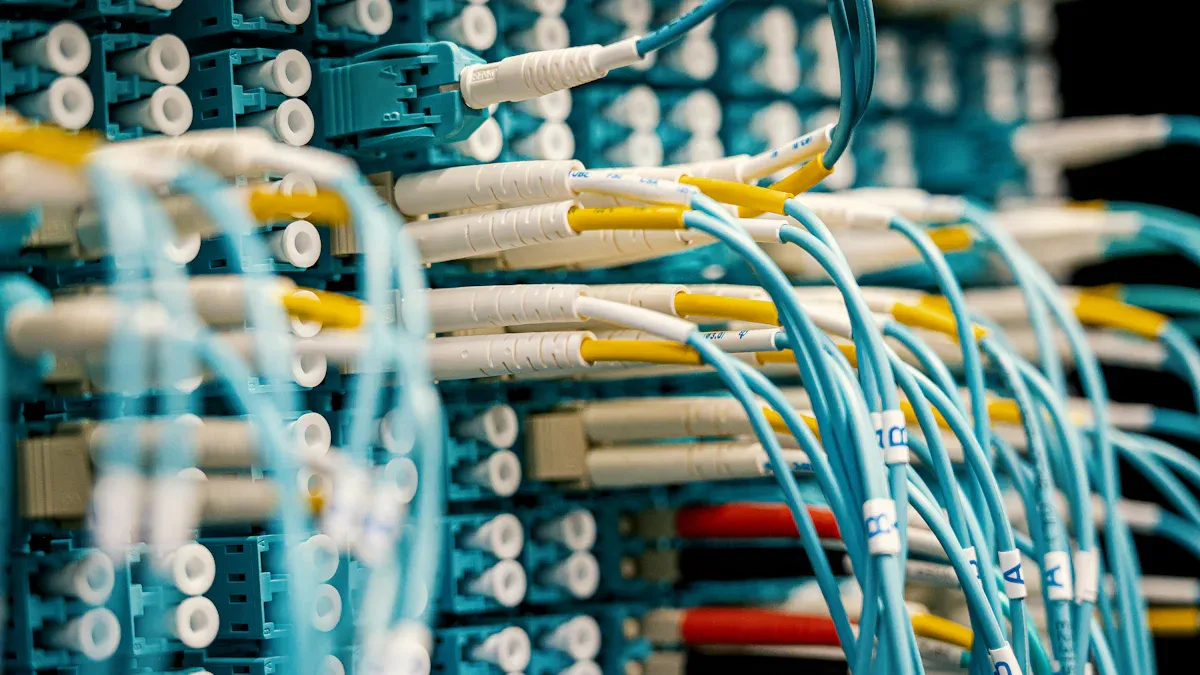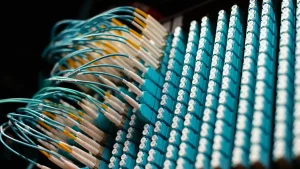
Efficient wind turbine communication is essential for the seamless operation of wind farms. 6-port media converters enhance this communication by facilitating faster data transmission and reducing latency. Their robust design ensures reliable network performance, even in challenging environments. Additionally, these converters support scalability, making them a future-proof solution for expanding wind farm SCADA networks.
Key Takeaways
- 6-port media converters help wind farms send data faster. They lower delays, making real-time checks and quick decisions possible.
- These converters work well in tough conditions. Their strong build and two power sources reduce the chance of network problems.
- 6-port media converters are easy to scale. Wind farms can grow their networks without big changes, supporting future needs.
Wind Farm SCADA Networks and Their Challenges

Role of SCADA Systems in Wind Turbine Communication
SCADA (Supervisory Control and Data Acquisition) systems serve as the backbone of wind turbine communication. These systems monitor and control turbine operations by collecting real-time data from sensors and devices. This data includes wind speed, rotor speed, and power output. Operators use SCADA systems to analyze performance metrics and make informed decisions to optimize energy production.
In addition to monitoring, SCADA systems enable remote control of turbines. Operators can adjust settings, such as blade angles or generator speeds, to maximize efficiency. This capability reduces the need for on-site personnel, lowering operational costs. SCADA systems also play a critical role in detecting anomalies. Early identification of potential faults ensures timely maintenance, minimizing downtime and preventing costly repairs.
Common Challenges in SCADA Networks
Despite their importance, SCADA networks face several challenges in wind farms. These challenges often stem from environmental and operational factors. For instance, SCADA parameters are highly dependent on operating conditions like wind speed and temperature. Fluctuations in these factors can impact data accuracy and system performance.
Another significant challenge is anomaly detection. Identifying faults in a network with numerous turbines requires advanced algorithms and robust monitoring tools. Without effective anomaly detection, minor issues can escalate into major failures, disrupting wind turbine communication and energy production.
| Challenge Type | Description |
|---|---|
| Dependency on Operating Conditions | SCADA parameters are highly influenced by factors like wind speed and environmental temperature. |
| Anomaly Detection Importance | Anomaly detection is crucial for identifying potential faults and ensuring proper functioning of turbines. |
Addressing these challenges is essential for maintaining reliable SCADA networks. Solutions like 6-port media converters can enhance data transmission and improve network resilience, ensuring uninterrupted communication across wind farms.
Understanding 6-Port Media Converters
Definition and Key Features
A 6-port media converter is a specialized device designed to bridge the gap between different types of network media, such as fiber optic and copper cables. It facilitates seamless data transmission by converting signals between these media types. This capability is particularly valuable in industrial applications, including wind turbine communication, where diverse network setups are common.
Key features of a 6-port media converter include:
- Model: Industrial Fiber Media Converter with 6 UTP ports and 2 Fiber ports.
- Ports: Six 10/100BaseTX electrical ports and two 100BaseFX fiber ports.
- Performance: Supports data speeds of up to 100 Mbps on fiber ports and 10/100 Mbps on electrical ports.
- Management: Offers web-based and CLI management options for easy configuration.
- Power Supply: Dual power input ensures high reliability in critical operations.
- Environmental Limits: Operates in extreme temperatures ranging from -40°C to +80°C.
- Dimensions and Weight: Compact design measuring 5 x 118 x 140 mm and weighing 760g.
- Warranty: Backed by a five-year warranty for long-term reliability.
These features make the 6-port media converter a robust and versatile solution for industrial networks.
Why They Are Ideal for Wind Turbine Communication
Wind turbine communication relies on efficient and reliable data transmission to ensure optimal performance. 6-port media converters excel in this domain by addressing key challenges in wind farm SCADA networks. Their ability to integrate fiber optic and copper connections enhances network flexibility, allowing operators to adapt to varying infrastructure requirements.
The dual power input feature ensures uninterrupted operation, even during power fluctuations. This reliability is critical for maintaining consistent communication between turbines and the SCADA system. Additionally, the converters’ wide operating temperature range makes them suitable for harsh environmental conditions often encountered in wind farms.
By supporting high-speed data transmission, 6-port media converters reduce latency and improve the accuracy of real-time monitoring. This capability enables operators to make timely decisions based on precise data. Their compact design simplifies installation in turbine nacelles or control rooms, further enhancing their practicality.
Advantages of 6-Port Media Converters in Wind Farms
Improved Data Transmission and Reduced Latency
6-port media converters significantly enhance data transmission in wind farm SCADA networks. By integrating fiber optic and copper connections, they enable high-speed data transfer across long distances without signal degradation. This capability ensures that critical information, such as turbine performance metrics, reaches the control center promptly. Faster data transmission reduces latency, allowing operators to respond to real-time changes more effectively. For example, adjustments to turbine settings can be made instantly, optimizing energy production and minimizing downtime.
The converters’ ability to handle large volumes of data also supports the seamless operation of multiple turbines. This feature is particularly valuable in large wind farms where efficient wind turbine communication is essential for maintaining overall performance.
Enhanced Network Reliability and Redundancy
Reliability is a cornerstone of any SCADA network, and 6-port media converters excel in this area. Their dual power input design ensures uninterrupted operation, even during power fluctuations or outages. This redundancy minimizes the risk of communication failures, which could disrupt turbine monitoring and control.
Additionally, these converters are built to withstand harsh environmental conditions, including extreme temperatures and humidity. Their robust construction ensures consistent performance, even in remote wind farm locations. By enhancing network reliability, 6-port media converters contribute to the long-term stability of wind farm operations.
Scalability for Future Expansion
As wind farms grow, their SCADA networks must adapt to accommodate additional turbines and infrastructure. 6-port media converters offer the scalability needed for such expansions. Their versatile design supports the integration of new network components without requiring significant changes to the existing setup.
Operators can easily add more turbines to the network while maintaining efficient communication and data flow. This scalability makes 6-port media converters a future-proof solution, ensuring that wind farms can meet increasing energy demands without compromising performance.
Case Study: Real-World Application in a Wind Farm

Overview of the Wind Farm Setup
A wind farm located in a coastal region faced unique challenges due to its remote location and harsh environmental conditions. The farm consisted of 50 turbines, each equipped with sensors to monitor performance metrics such as wind speed, rotor speed, and energy output. The SCADA network connected these turbines to a central control room, enabling operators to manage operations and analyze data in real time. The network relied on a combination of fiber optic and copper cables to transmit data across long distances.
The farm’s operators sought to enhance the efficiency and reliability of their SCADA network. They needed a solution that could handle high-speed data transmission, withstand extreme temperatures, and support future expansion as the farm grew.
Challenges Addressed by 6-Port Media Converters
The wind farm’s SCADA network faced several challenges. Signal degradation over long distances impacted data accuracy, while power fluctuations caused occasional communication failures. The harsh coastal environment, with its high humidity and temperature extremes, further strained the network’s reliability. Additionally, the operators required a scalable solution to accommodate new turbines without overhauling the existing infrastructure.
6-port media converters addressed these issues effectively. Their ability to integrate fiber optic and copper connections ensured seamless data transmission, even over extended distances. The dual power input feature provided redundancy, minimizing the risk of communication disruptions. Their robust design allowed them to operate reliably in extreme environmental conditions, making them ideal for wind turbine communication.
Outcomes and Performance Improvements
The integration of 6-port media converters transformed the wind farm’s SCADA network. Data transmission speeds improved significantly, reducing latency and enabling real-time monitoring of turbine performance. The network’s reliability increased, with fewer communication failures reported. Operators could quickly identify and address anomalies, preventing potential downtime.
The scalability of the converters allowed the farm to add new turbines without disrupting the existing network. This flexibility supported the farm’s growth while maintaining efficient operations. Overall, the implementation of 6-port media converters enhanced the wind farm’s operational efficiency and prepared it for future expansion.
Best Practices for Integrating 6-Port Media Converters
Assessing Network Requirements
A thorough assessment of network requirements is essential before integrating 6-port media converters. Operators must evaluate the current infrastructure, data transmission needs, and environmental conditions. This process ensures that the selected media converters align with the network’s demands and operational goals.
Key factors to consider during the assessment include:
- The growing demand for high-speed data rates driven by IoT and edge computing technologies.
- The need for advanced solutions, such as 10 Gigabit Ethernet, to handle high data throughput.
- The importance of reliable and fast communication in evolving industrial networks.
By analyzing these factors, operators can identify potential bottlenecks and determine the specifications required for optimal performance. This proactive approach minimizes compatibility issues and ensures a seamless integration process.
Selecting the Right Media Converters
Choosing the appropriate 6-port media converters involves evaluating their features and compatibility with the existing network. Operators should prioritize converters that support both fiber optic and copper connections, as this flexibility accommodates diverse infrastructure setups. Additionally, converters with dual power input and wide temperature ranges are ideal for harsh environments like wind farms.
When selecting media converters, operators should also consider:
- Data speed capabilities to ensure efficient communication.
- Management options, such as web-based interfaces, for easy configuration.
- Compact designs that simplify installation in confined spaces.
Selecting the right media converters enhances network reliability and prepares the system for future scalability.
Ensuring Proper Installation and Maintenance
Proper installation and maintenance are critical for maximizing the performance of 6-port media converters. During installation, operators should follow manufacturer guidelines to ensure secure connections and optimal placement. For example, placing converters in well-ventilated areas can prevent overheating and extend their lifespan.
Regular maintenance is equally important. Operators should:
- Inspect connections periodically to identify wear or damage.
- Update firmware to maintain compatibility with evolving technologies.
- Monitor performance metrics to detect potential issues early.
By adhering to these best practices, operators can ensure the long-term reliability and efficiency of their SCADA networks.
SCADA networks are essential for monitoring and controlling wind farm operations. However, they face challenges like data accuracy and network reliability.
- 6-port media converters address these issues by:
- Improving communication efficiency.
- Enhancing network reliability.
- Supporting scalability for future growth.
These converters optimize wind farm performance, ensuring seamless operations and readiness for expansion.
FAQ
What makes 6-port media converters suitable for harsh environments?
Their robust design, wide operating temperature range (-40°C to +80°C), and dual power input ensure reliable performance in extreme conditions like those found in wind farms.
How do 6-port media converters improve SCADA network scalability?
These converters support seamless integration of additional turbines and infrastructure, enabling wind farms to expand without requiring significant changes to the existing network setup.
Can 6-port media converters reduce operational costs in wind farms?
Yes, by enhancing data transmission and network reliability, they minimize downtime and maintenance needs, leading to lower operational expenses and improved efficiency.
Tip: Regular maintenance of media converters ensures optimal performance and extends their lifespan, making them a cost-effective investment for wind farm SCADA networks.



